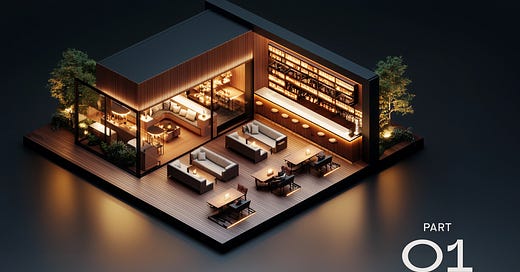Ever walk into Soho House and feel like every corner has something going on?
Agency execs in Sambas posting up to pitch their new clients, tech bros slinging their corporate branded work bags underneath the table, and remote work guru’s transitioning from zoom-appropriate attire to swim suit in a Clark Kent flash.
The rooms all have vibes, ranging from full-on social, to busy work environment, to chill lounge – with the intensity and activities changing throughout the day and into the night.
On the other hand....
Ever walk into a multi-family “co-working” space and feel like the zombie apocalypse just swept through your city? And the one woman with her laptop in the big booth is legitimately the last human on earth?
Or cruise through the lobby of the brand new “flight to quality” office building and the space has no people – like a Miller Knoll catalog?
Or pop into your Hyatt-in-disguise “boutique” hotel gym to find a weekend warrior on the treadmill and the rest of the room completely to yourself?
We’re sure you have. It’s a plague we call the Corporate Amenity Curse™ – it kills the utilization of your program – and the antidote is making your amenities feel more like home.
Before we get into the nitty gritty of what could make something feel like home, it’s important to call out two nerdy design ideas that help us understand home: affordances and signifiers.
Affordances are the properties of an object (like a piece of furniture) or a space (like an amenity) that indicate how it can be used or interacted with. The classic example: the design of a chair affords sitting on and standing on (and throwing if you’re a little nuts).
Signifiers indicate the possibility of an affordance. They tell you exactly how you can and should utilize an object. How does this show up in spaces? Very explicitly through wayfinding and signage.
Guess what? You’re dealing with a bad case of Corporate Amenity Curse™ because your affordances and signifiers are all wrong or absent.
Here’s how to fix them:
01. Reduce the scale of your amenities.
You’re allocating too much space to each component of your plan. We call this miss the Paradox of Space™ – which is that developers assume people want a lot of space, but in reality, people want a lot of smaller, different spaces. For instance, many lobbies are transition zones: we use lobbies as circulation for coming and going. Yet, most lobbies are way too massive. We simply don’t need that much space to transition to somewhere else.
In fact, the openness of your plan is an anti-affordance (we may have just made that word up, but you get the idea): our predominant mental model is that of a home, with a number of distinct, intimately sized rooms that afford us different activities, such as living rooms that are for watching TV and socializing, reading nooks for reading, bars for entertaining, and even mudrooms for moving in and out of the house (consider the mudroom a good proof point for the oversized lobby example above).
We have the emotional association of feeling most comfortable in smaller spaces. When we encounter really big open spaces we’re simultaneously lost in the potential affordances of those rooms and uneasy in their openness.
In many ways, Soho House is so successful in activating its program because it chops an open plan into a number of smaller layers that resemble rooms in a home. There’s a certain inherent flexibility in their program–it’s way better to be flexible than overly prescriptive–but you could more or less map each Soho room back to a space type in a single family home.
02. Make your FFE resemble home.
To put it simply: most furniture in commercial real estate is too corporate. We’re guessing the intent in choosing your FFE is: a) make it durable: you expect lots of butts to sit on those daybeds b) make it impressive: you want your customer to feel like the furniture is something they simply couldn’t purchase on their own and c) make it meet the moment: find something on trend that keeps up with the joneses.
The end result? A number of pieces that say (in affordance-terms): “don’t sit on me.” We’ve all seen the showcase clusters in the middle of the lobby, the highly choreographed, stark deck chairs by the pool, and the long wooden communal desks with little outlets popping out in the co-working space. In many ways, we don’t want to hang out in these spaces because the furniture isn’t terribly homey.
The materiality, comfort, scale, orientation, clustering and layering of your furniture should all resemble home…even if it’s an unusually badass, professionally designed, and tasteful home. To make your space somewhere people want to be, consider accessorizing your furniture with the same accents as a home: throw pillows, blankets, coasters, etc.
Back to our Soho House example: at Soho, worn leather furniture, small wooden desks, coffee tables, side tables, throw pillows/blankets abound, making the club feel like a stylish home.
03. Use signifiers to tell people how to use your space like they would at home.
The reality? We’ve been untrained to see commercial apartments, offices, and hotels as places we want to be (aka where we can–within reason, and with professionalism and social grace–strive to achieve the same level of comfort as at home).
One way we can re-train consumers to be comfortable in our spaces is through signifiers…specifically signage, wayfinding, and other design communication like iconography…all that subconsciously helps us understand how to utilize spaces.
How does this play out? In an obvious way: you can tell people that the soft seating cluster is for hanging out, with a little sign that says: “sit down, stay a while.” You could call the club room “the living room.” You could even commission a small illustration of someone with their feet up, reading up a book, drinking some coffee, next to your lounge chairs.
If this seems insane, take stock of the signage and wayfinding at places like Soho House and The Hoxton. You’ll see signs/wayfinding/icons that help consumers understand the affordances of their spaces–and specifically manifest activities you would expect more at home than anywhere else.
We know, it’s a lot to digest.
We’re not expecting you to mirror your corporate office after a house you see in Dwell Magazine. Or hire grandma to put plastic on your couches. Or buy a dog to chew up your rugs.
But if you’re having issues getting people to use your spaces, try out our thinking. It may just give you a leg up in the market.
Missed our feature in The Brand Identity? Check it out now.
🚨 WHO IS NO WALLS STUDIO (AND WHAT DO WE DO)?
No Walls Studio is a design and brand consultancy that helps real estate developers create spaces that people love.
Our mission is to make sameness extinct in real estate, which means that everything we do comes with new ideas and unique angles — all, grounded in a deep understanding of culture and consumers.
We do three things for our clients (often, all in the same project):
Research & Insights
Brand Development
Spatial Experience Design
Want to work with us or learn more?













